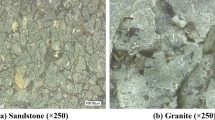Abstract
—Uniaxial compression, triaxial compression and Brazialian tests were conducted on several kinds of rock, with particular attention directed to the principal tensile strain. In this paper we aim to clarify the effects of the experimental environment—such as confining pressure, loading rate, water content and anisotropy—on the critical tensile strain, i.e., the measured principal tensile strain at peak load.¶It was determined that the chain-type extensometer is a most suitable method for measuring the critical tensile strain in uniaxial compression tests. It is also shown that the paper-based strain gage, whose effective length is less than or equal to a tenth of the specimen’s diameter and glued on with a rubber-type adhesive, can be effectively used in the Brazilian tests.¶The effect of confining pressure P C on the critical tensile strain ɛ TC in the brittle failure region was between −0.02 × 10−10 Pa−1 and 0.77 × 10−10 Pa−1. This pressure sensitivity is small compared to the critical tensile strain values of around −0.5 × 10−2. The strain rate sensitivities ∂ɛ TC /∂{log(d|ɛ|/dt)} were observed in the same way as the strength constants in other failure criteria. They were found to be from −0.10 × 10−3 to −0.52 × 10−3 per order of magnitude in strain rate in the triaxial tests. The average magnitude of the critical tensile strain ɛ TC increased due to the presence of water by 4% to 20% for some rocks, and decreased by 22% for sandstone. It can at least be said that the critical tensile strain is less sensitive to water content than the uniaxial compressive strength under the experimental conditions reported here. An obvious anisotropy was observed in the P-wave velocity and in the uniaxial compressive strength of Pombetsu sandstone. It was not observed, however, in the critical tensile strain, although the data do show some variation.¶A "tensile strain criterion" was proposed, based on the above experimental results. This criterion signifies that stress begins to drop when the principal tensile strain reaches the critical tensile strain. The criterion is limited to use within the brittle failure region. The critical tensile strain contains an inelastic strain component as well as an elastic one. It is affected by the strain rate, however, it is relatively insensitive to the confining pressure, the presence of water and anisotropy.
Similar content being viewed by others
Author information
Authors and Affiliations
Additional information
Received October 10, 1996, accepted April 13, 1998.
Rights and permissions
About this article
Cite this article
Fujii,, Y., Kiyama,, T., Ishijima, Y. et al. Examination of a Rock Failure Criterion Based on Circumferential Tensile Strain. Pure appl. geophys. 152, 551–577 (1998). https://doi.org/10.1007/s000240050167
Issue Date:
DOI: https://doi.org/10.1007/s000240050167




